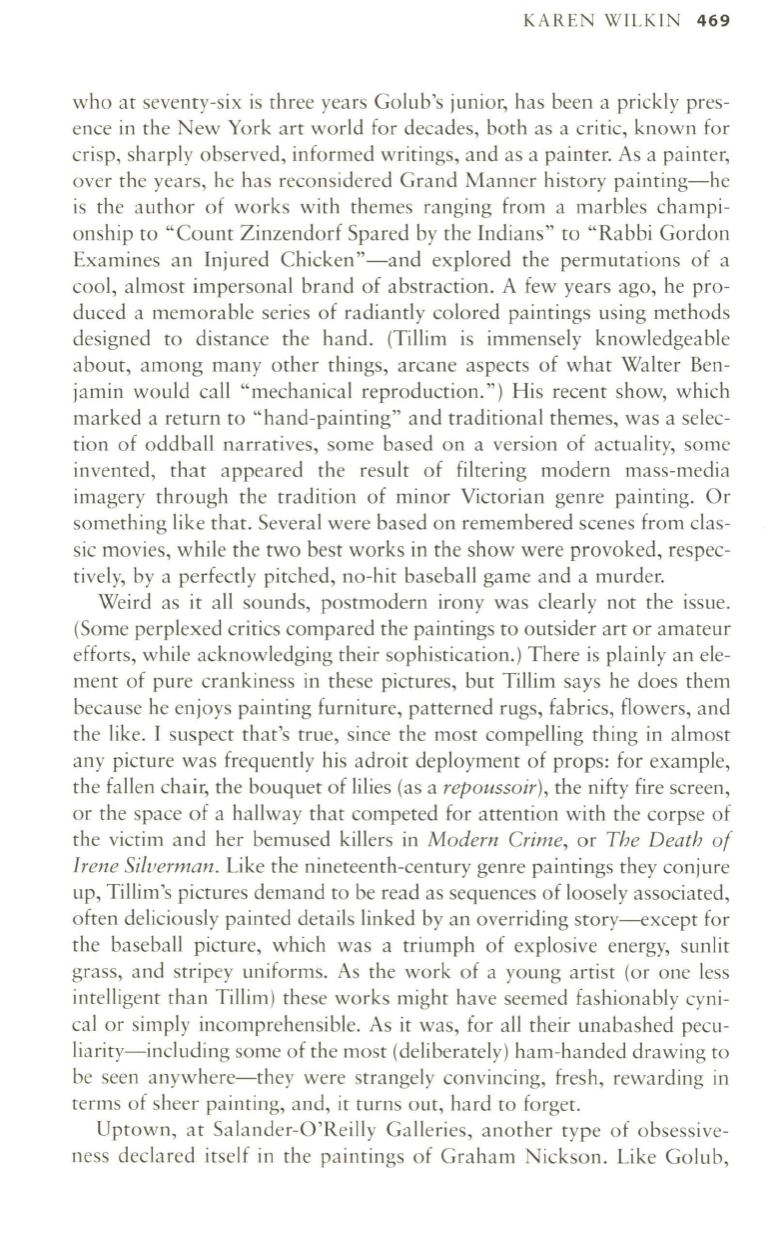
KAREN WILKIN
469
who at seventy-six is three years Golub's junior, has been a prickly pres–
ence in the New York art world for decades, both as a critic, known for
crisp, sharply observed, informed writings, and as a painter. As a painter,
over the years, he has reconsidered Grand Manner history painting-he
is the author of works with themes ranging from a marbles champi–
onship to "Count Zinzendorf Spared by the Indians" to "Rabbi Gordon
Examines an Injured Chicken"-and explored the permutations of a
cool, almost impersonal brand of abstraction . A few years ago, he pro–
duced a memorable series of radiantly colored paintings using methods
designed to distance the hand. (Tillim is immensely knowledgeable
about, among many other things, arcane aspects of what Walter Ben–
jamin would ca ll "mechanica l reproduction.") His recent show, which
marked a return to "hand-pa inting" and traditional themes, was a selec–
tion of oddball narratives, some based on a version of actua lity, some
invented, that appeared the result of filtering modern mass-media
imagery through the tradition of minor Victorian genre painting. Or
something like that. Several were based on remembered scenes from clas–
sic movies, while the two best works in the show were provoked, respec–
tively, by a perfectly pitched, no-hit baseball game and a murder.
Weird as it all sounds, postmodern irony was clearly not the issue.
(Some perplexed critics compared the paintings to outsider art or amateur
efforts, while acknowledging their sophistication.) There is plainly an ele–
ment of pure crankiness in these pictures, but Tillim says he does them
because he enjoys painting furniture, patterned rugs, fabrics, flowers, and
the like. I suspect that's true, since the most compelling thing in almost
any picture was frequently his adroit deployment of props: for example,
the fallen chair, the bouquet of lilies (as a
repoussoir),
the nifty fire screen,
or the space of a hallway that competed for attention with the corpse of
the victim and her bemused killers in
Modern Crime,
or
The Death of
Irene Silverman.
Like the nineteenth-century genre paintings they conjure
up, Tillim's pictures demand
to
be read as sequences of loosely associated,
often deliciously painted details linked by an overriding story-except for
the baseball picture, which was a triumph of explosive energy, sunlit
grass, and stripey uniforms. As the work of a young artist (or one less
intelligent than Tillim) these works might have seemed fashionably cyni–
calor simply incomprehensible. As it was, for all their unabashed pecu–
liarity-including some of the most (deliberately) ham-handed drawing to
be seen anywhere-they were strangely convincing, fresh, rewarding in
terms of sheer painting, and, it turns out, hard
to
forget .
Uptown, at Salander-O'Reilly Galleries, another type of obsessive–
ness declared itself in the paintings of Graham Nickson. Like Golub,


